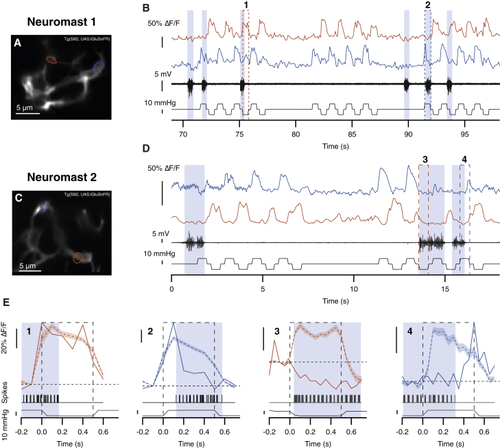Figure 3
- ID
- ZDB-FIG-200112-27
- Publication
- Pichler et al., 2019 - Motor Behavior Selectively Inhibits Hair Cells Activated by Forward Motion in the Lateral Line of Zebrafish
- Other Figures
- All Figure Page
- Back to All Figure Page
|
Motor Behavior Blocks Synaptic Transmission from a Subset of Hair Cells Experiments were carried out in relaxed mutants that express the glutamate reporter iGluSnFR in afferent neurons ( (A and B) Image of iGluSnFR expression in afferents of neuromast 1 (A). Two representative synaptic inputs are highlighted in red (activated by anterior deflection) and blue (activated by posterior deflection). The responses of these synapses to mechanical stimuli are shown in (B), together with motor nerve activity (black traces) and pressure steps applied to the neuromast. Positive pressure steps correspond to posterior deflections of the cupula and negative steps to anterior deflections. Blue shading indicates periods of motor nerve activity, and numbered boxes indicate the stimulation episodes that are magnified in (E). (C and D) A corresponding representation of hair cell activity in neuromast 2. (E) Expansion of records in boxes 1–4 in (B) and (D). The superimposed dashed red and blue traces indicate the average mechanically induced response of that synapse in the absence of motor nerve activity. Shaded areas represent the SEM. In example 2, inhibition of glutamate release is almost complete within 50 ms of the beginning of the motor burst. In example 3, suppression is complete within 50 ms, and further motor activity reduces glutamate release below resting levels. In example 4, glutamate release begins to recover within 50 ms of the end of the motor burst. See also |

